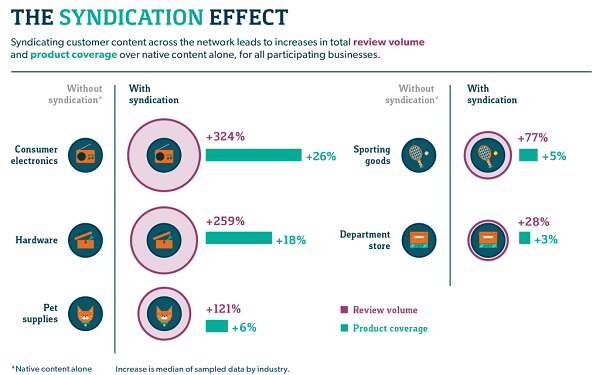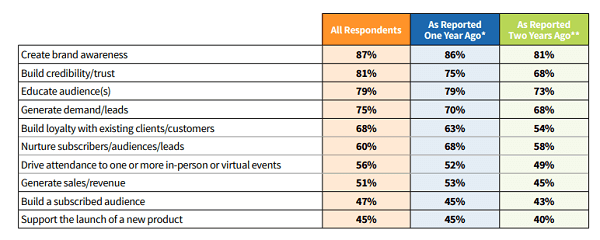
Introduction
Creating great content isn’t enough. You need to make sure that it reaches large audiences who are likely to be interested in your brand and products/services.
One of the best ways to do so is to use content syndication.
This content distribution strategy involves getting your content republished by third-party sites and networks to gain more exposure and leads for your business.

Image Source – iZooto
Before I tell you how to syndicate your content, let’s quickly discuss what it is and why it should matter to you.
What is Content Syndication & Why Does it Matter?
Content syndication refers to the process of republishing and promoting your original web content on third-party websites. You can syndicate articles, infographics, videos, podcasts, and other content types to reach wider audiences.
Now the question is: Why should you consider using content syndication?
It offers multiple benefits and is a kind of barter arrangement.
Wondering how?
Well, you get free exposure, backlinks, and increased website traffic as a content creator. Whereas, the site that syndicates your content gets free, relevant content to engage their audience and keep their site updated.
Leveraging content syndication can help you:
Gain More Exposure for Your Products and Services
Most content syndication networks have large, established audiences, which is why republishing your content there can boost its reach significantly. You can get more people to view and learn about your products and services.
Here’s how the syndication effect works:

Image Source – iZooto
Generate High-Quality Leads That Are Ready to Convert
Content syndication can help small and medium-sized businesses generate qualified leads for their product and services.
Wondering how?
It can help you deliver high-value content to the right prospects. You should consider syndicating resources such as comprehensive articles, industry reports, news releases, and whitepapers for greater engagement.
Syndicating them can help you tap into new audiences who might show interest, download your resource, visit your site, or inquire about your product or service. It is essential that you keep an eye on these prospects.
This way, you can generate top-of-the-funnel MQL and SQL leads by amplifying the reach of your content by syndicating it.
Drive More Website Traffic
When a website syndicates your content, it also gives a backlink to the original location of the article. Their readers are likely to click on those links and visit your website to get more unique information about the topic.
However, in order to attract referral visitors, you need to ensure that the content you syndicate is of high-quality. It should be relevant and valuable for the target audience of your partner websites.
Build Your Brand’s Credibility and Trust
Republishing content on other authoritative websites improves your brand image. It can keep you on the top of your readers’ minds when they need your product or service.
People and search engines, both are likely to trust you and find you more credible.
Improve Your SEO Results
Syndicating your content on third-party websites and acquiring high-quality backlinks can help you tell search engines that your content is reliable and trustworthy.
You can not only get more backlinks and increased website traffic but also build trust and credibility in your niche. This will help enhance your domain authority and boost your content’s search rankings.
However, if not done right, content syndication can also lead to penalties and decreased rankings. To avoid these SEO risks, make sure that you follow safe syndication practices.
P.S. I’ve shared the safe syndication practices in the sections below for your ease.
Who Should Leverage Content Syndication?
Thinking about whether or not content syndication is for you?
Let me tell you that the following groups of people should leverage content syndication to reach and engage their target audiences:
- Small businesses
- Medium-sized businesses
- Large Corporations
- Bloggers
- Individual marketers
- Entrepreneurs
- Anyone who wants to build a personal brand
Why?
Because content syndication is:
- Cost-effective: You can use the same content again and again to create new leads and drive more backlinks, traffic, and sales.
- Offers numerous benefits: From backlinks to traffic, leads, sales, credibility, SEO boost, and more.
- Easy to implement: Once you get a hand at it, you can easily republish your content on multiple platforms and websites seamlessly.
How to Get Started With Content Syndication
Just like other marketing tactics, content syndication will be the most effective if you’ve got a solid strategy in place. You should define your goals, create great content, identify relevant syndication partners, and plan ahead to generate significant results.
Let’s discuss this step-by-step content syndication plan in detail.
Define Your Goals
A majority of marketers use content marketing to achieve goals such as creating brand awareness, building credibility and trust, and generating demand or leads.

Image Source – CMI
Understanding what you want to achieve from content syndication will help you create a better strategy.
You should ask yourself:
- Will syndicating this content serve your business goals?
- Will it redirect users to pages that are optimized for conversions?
- Will it help you stand out on the syndication sites and networks?
Leverage the Best Content Types for Content Syndication
Here are the most popular types of content that marketers use for content syndication:
Blog Posts
Insightful blog posts that educate users or help them improve their skills are easy to syndicate. You can use tools like BuzzSumo to research trending topics in your niche and create comprehensive guides and listicles on them.
Some blog post ideas:
- How-to guides
- Tools’ listicles
- List of strategies, tips, tricks, hacks
- Useful Strategies + Examples
While creating blog posts, you can use tools such as Grammarly, Hemingway Editor, and ProWritingAid to spot and fix errors.
Infographics
You can also syndicate visual content such as charts and infographics. These content formats make it easier for users to consume complex information, which is why they are really easy to syndicate.
You can easily give an embed code for your infographic to your syndicating partner. They will just need to copy and paste the code to embed your infographic on their site.
Many sites may ask for a short description to go with your infographic.
Design tools such as Canva, Piktochart, and Venngage can help you create beautiful infographics using built-in templates and elements.
Videos
You can create videos that feature your products and services and syndicate them to get your content in front of new, diverse audiences. It can also help you drive traffic to your website.
Some of the most popular video syndication sites you can use include YouTube, Facebook, TikTok, and Instagram. If your videos are entertaining or informative enough, they can get more shares and reshares, increasing their reach by n times.
Make sure that you include your brand’s logo and website URL or contact number in the video. Even if people forget to link back to the original source, their audiences can still recognize your brand as the original creator.
Audios
You can record interviews and podcast episodes as audio clips and syndicate them to increase their reach. The best platforms for audio syndication include iTunes, Spotify, and SoundCloud.
Case Studies and Industry Reports
Case studies and industry reports require more research and effort but they are likely to get syndicated easily.
A majority of content creators willingly link back to insightful industry resources that share:
- Recent statistics
- Pros and cons
- Widely-accepted practices
- Success stories
- Mistakes to learn from (failure stories)
Pro tip: Regardless of the content type you choose, you should focus on its quality and relevance to your target audience.
Find the Right Content Syndication Networks
When syndicating content, you should make sure that you republish it on popular, high-traffic, high-ranking websites that can help you reach your target audience.
Let’s take a look at some of the most popular content syndication networks.
RSS Feeds
RSS refers to Really Simple Syndication. RSS feed is basically an XML-based format for your content. The people who visit your website can subscribe to your RSS feed and get your new posts in their RSS reader such as Google Reader.
You can:
- Use your blogging platform’s built-in RSS feed.
- Set up Feedburner for your blog’s RSS feed to track subscribers’ activity.
- Send your RSS feed to Twitter via Twitterfeed.
- Submit your RSS feed to RSS directories such as Alltop and Blogville.
There are two ways to syndicate and distribute content on LinkedIn. You can either promote the link to your content using short LinkedIn status posts or syndicate the entire content as a LinkedIn article.
Syndicating content on LinkedIn is as easy as logging into the platform and clicking on “Write article.”

Image Source – LinkedIn
Don’t forget to add “Originally published at + your website’s name and link to the post” at the end of the article.
LinkedIn also allows you to see how your syndicated articles are performing. You can get insights about which company your readers work at, their job titles, and how most people found your article.

Image Source – Social Media Examiner
Q/A Forums Like Quora
Q/A forums like Quora allow you to ask questions and participate in discussions. You should choose ongoing discussions related to your niche and business and write answers to people’s questions.
You can also add links to valuable resources you’ve created on the topic. Make sure that the resource you syndicate is relevant to the topic of discussion and adds more value to your answer.
You can also give direct mentions to relevant landing pages to drive qualified leads to your site.

SlideShare
SlideShare allows you to create demos and slides to educate audiences about any topic. Many creators repurpose their informative blog posts, “how-to” guides, and research reports in the form of visually-rich slides.
Here’s an example of DataReportal syndicating its digital media report on SlideShare:

Medium.com
It is a great platform for publishing content, photos, and videos directly.
Syndicating your content on Medium.com can help you get:
- Large audiences: Top stories also get featured prominently for extra exposure.
- Increased readership: Many avid readers use the platform regularly.
- Real engagement: You can get insights into the number of views and average reading time for each of your stories.
- New social media followers: People who like your content are likely to follow you on social media. Don’t forget to link your Medium account to your other social profiles.
You just need to create an account if you want to start publishing your stories on Medium. At the bottom of the article, you should write:
Originally published at + your website’s name and link to the post
If you don’t want to copy-paste your content for republishing, Medivum also has a built-in import tool that allows you to simply import your existing content from anywhere on the web. You can edit and format it and then hit the “publish” button.
That’s not all.
If you’ve got a Stripe account and if you’re able to build a decent readership on Medium, you can also earn direct money by joining their Partner Program.
Medium pays writers and content syndicators every time Medium members spend their time reading your work. You can expect monthly payouts.
StumbleUpon (now Mix.com)
StumbleUpon site allows you to submit your favorite web pages, follow people, and share content. Readers can browse through trending articles, photos, and videos and also follow their favorite creators.
If your content is worth it, you’re likely to gain more traction, website traffic, and leads by syndicating it on StumbleUpon.
Tumblr
Tumblr is a simple platform that provides a live feed of the blogs its users want to track. You can easily post anything from photos to GIFs, TV shows, videos, links to your content, Spotify tracks, and other audios on Tumblr.
If a user likes your content and follows your blog, they will be able to see all of your posts on their dashboard. They can even reblog your post on their blog, which is what content syndication is all about.
Partner Sites That Allow Content Syndication
When partnering with websites run by other publishers, you will have to pitch them with your content syndication proposal. Some of the popular sites that accept syndicated content include Business 2 Community, HubSpot, and Social Media Today.
Some quick tips that can help you get your syndication proposal approved, include:
- Many sites have multiple categories of content. Make sure that you find the name and email ID of the editor who is responsible for publishing articles in your category.
- Establish a relationship with the editor by commenting on their recent posts. Only comments with a substance allowed!
- Understand their writing style and topic preferences. Analyze whether they prefer more examples or statistics.
- Reach out to them with the posts you want them to republish on their site and state reasons why they should consider syndicating your content.
- Be polite and respectful.
- Don’t refrain from making small edits. Some editors are highly particular about their formatting and writing style guides.
Taboola
Taboola is a content discovery tool that allows you to distribute your content across premium publications that have large audiences. You can also make money by attracting users to your content.
Outbrain
Outbrain is another content marketing platform that allows you to showcase your content on big media outlets such as CNN and MSN.
Decide on a Content Syndication Approach
Usually, brands syndicate entire articles and blog posts to third-party websites like Medium.com. But there are times when you can syndicate just the headline and a short description of your post with a link back to your website.
When syndicating infographics, many sites ask you to provide a unique 300-400 words long description to be published with your infographic.
Leverage Content Syndication Services
Many companies also consider outsourcing their content syndication efforts to professionals.
If you find this process too complex and tedious, you can hire experienced content marketers to create and syndicate high-converting content for your business.
Check out the advanced content syndication services that UnboundB2B experts have to offer.
Measure the Performance of Your Syndicated Content
The success of your content syndication efforts will differ according to the goals you set initially. However, a few metrics can help you measure results effectively, such as:
Return on Investment (ROI)
The most basic KPI to measure the success of any marketing activity is the campaign ROI. You should compare the expenses of your content syndication efforts to the revenue generated.
If your main goal is not generating revenue but increasing the number of downloads, you can measure success by the number of prospects who downloaded your resource.
Quality and Quantity of Leads Generated
The more leads you generate, the better. But at the same time, the quality of leads also matters a lot.
You need to make sure that the leads you’ve generated have the potential to get converted into actual paying customers. Otherwise, your content syndication efforts will be pointless and a complete waste of time and resources.
Amount of Traffic Generated
Website traffic growth can be an easy way to judge the effectiveness of your content syndication campaign. You can also track the sources of traffic to analyze which syndicating partners and content types helped you bring maximum traffic to your site.
Increase in Your Brand’s Visibility
It can be challenging to track an enhancement in your brand’s image, visibility, and traction. But you might be able to see measurable gains in brand mentions and conversations over time by using tools like Brand24.
Engagement Rate
You can get an idea about your content’s engagement rate by answering the questions below.
- How many people are actually spending quality time reading your content?
- Are they commenting on your posts and videos?
- How many people are sharing your content in their circles?
Quick Tips for Safe Syndication
Are you worried that syndicating your content will lead to duplicate content issues?
There is nothing to worry about if you follow safe syndication practices. You should ask the site syndicating your content to:
- Place a “rel=canonical” tag on the page where they republish your article. The tag should point back to the original link of your article.
Doing this will help tell the search engines about the location of the original article.
- Use a “noindex” tag on their syndicated copy of the article to tell the search engines to prevent their copy from being indexed.
- Add the link to the original article to clearly display that the article was originally published on your website.
Ready To Improve Your Brand’s Exposure Using Content Syndication?
Now it’s your turn to start creating and syndicating your content for greater exposure.
You can use multiple content syndication platforms/networks to amplify the reach of your content. Don’t forget to create different types of content such as text, visual, audio, and video content to get the most out of your syndication strategy for 2021.
Do you need help amplifying your brand’s reach using content syndication? Feel free to hire our experts to do it for you.
P.S. We have helped businesses reach 60 million B2B contacts and generate MQL & SQL leads.
Our blog
Latest blog posts
Tool and strategies modern teams need to help their companies grow.

Programmatic ABM combines the effectiveness of targeted engagement with automation. I...

Take advantage of the year-end holiday rush so you can boost your SaaS revenue and st...

Boundaryless, cross-functional leadership is the key to successful, high-performing p...






